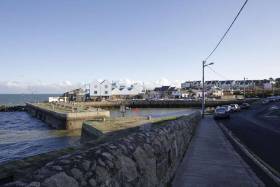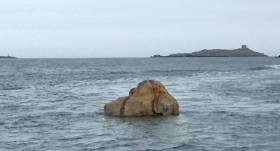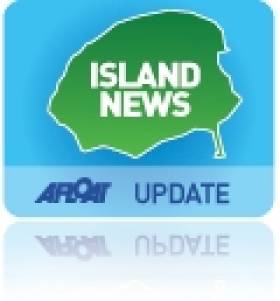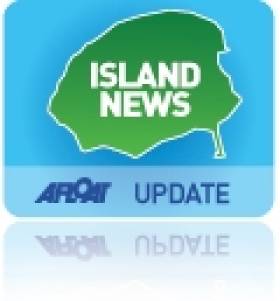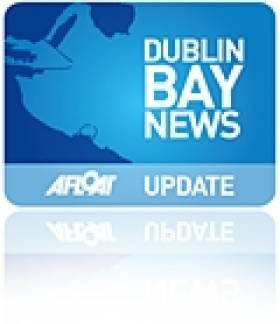Displaying items by tag: dalkey
Two dogs had a lucky escape after they were swept out to sea while chasing seals off Dalkey in Dublin Bay on Tuesday afternoon (22 August).
According to Independent.ie, it’s understood that the two golden retrievers were pulled away from the shore by a strong current — prompting a call-out for the Dun Laoghaire Coast Guard Unit and Dun Laoghaire RNLI to the scene.
In the meantime, one of the dogs safely made its way back to the rocks on its own while a local ferry boat was able to recover the other one from the water.
The incident came just two days after two swimmers were rescued by the local lifeboat when they were separated from their group, as reported on Afloat.ie.
Swimmer Dies After Getting Into Difficulty Off Dalkey
A swimmer rescued off Dalkey yesterday afternoon (Thursday 3 June) has died in hospital, as TheJournal.ie reports.
It’s understood the deceased, a man in his 20s, had been swimming at the Vico Baths below Hawk Cliff when he got into difficulty.
According to the Irish Independent, the young man was pulled from the water by a nurse who was present at the scene and a garda who was alerted to the incident that prompted a multi-agency response.
In a statement, the Irish Coast Guard said the man was subsequently airlifted by the Dublin-based helicopter Rescue 116 to Beaumont Hospital where he was later pronounced dead.
Lifeboat volunteers at Dun Laoghaire RNLI, which also responded to the emergency, said they were “extremely saddened” by the news of the swimmer’s passing.
“It's an outcome that our crew and our colleagues in the Irish Coast Guard never want to see,” they added.
“Our condolences are with the family and friends of this young man.”
Restored ‘ÉIRE’ Sign In Dalkey Set For Official Unveiling
The Dalkey Tidy Towns team is now ready for the official unveiling of the restored World War II-era ÉIRE sign at Hawk Cliff below the Vico Road.
This past summer the rediscovered information panel — one of 80 installed around the coastline during what was known as the ‘Emergency’ in neutral Ireland — was returned to its original condition, as reported on RTÉ News.
The work over half a year involved 1,700 hours of excavation, the lifting, cleaning and restoration of 100 tonnes of stones, the application of four tonnes of dry mortar as well as 170 litres of lighthouse paint.
The ÉIRE panel was rediscovered soon after the remnants of a sign on nearby Bray Head were spotted among a host of archaeological finds across the country revealed from the air after the drought of summer 2018.
Dalkey Tidy Towns will officially unveil the Hawk Cliff sign next Tuesday 24 September at 3pm in what it promises to be a “special occasion” with an Air Corps flyover, weather permitting.
Development at Bulloch Harbour in Dalkey Gets Go-Ahead
The Irish Times writes of a controversial development proposal for a scenic south Dublin fishing harbour has been given the go ahead by An Bord Pleanála.
Bartra Property, after a protracted planning struggle, has received permission to build a number of housing units at Bulloch Harbour in Dalkey.
It will consist of three three-storey houses, two apartments and a cafe as well as a number of other buildings.
Residents living at and near the picturesque coastal inlet, popular with tourists and for fishing, have long battled the proposals they believe are out of kilter with the surrounding area. Concerns have also been repeatedly aired as to the potential for flooding due to often high sea levels.
Local People Before Profit TD Richard Boyd Barrett said the decision was “incomprehensible”.
“Bulloch Harbour is a unique public amenity used by people of all ages. It is an important part of the heritage of south County Dublin, ” he said.
For more on this coastal development click here.
Bullock 200th Lecture: "The Port Across the Bay - Evolution from the Early 19th Century to 2040"
#lectures - As part of the Bullock Harbour Bicentenary celebrations, the next lecture is to be held on Tuesday (12 March) in the Dalkey Castle and Heritage Centre.
The free lecture programme which began last year has been organised by the Bullock Harbour Preservation Association (BHPA) in conjunction with the Dublin Port Company. So far the lecture themes have concentrated on the history and heritage of Bullock, an attractive small stone cut harbour located near Dalkey town.
As for the next lecture this will take focus onto the horizon!... as the talk's title is "The Port across the Bay - evolution from the early 19th century to 2040". The lecture is to be presented by Eamonn O'Reilly, Chief Executive Officer of the Dublin Port Company.
All are welcome to the lecture which will take place at 8pm in the Dalkey Castle & Heritage Centre.
Please be advised that there is now no need to book places as admission is free and the venue is large enough to accommodate all-comers.
A New Dublin Bay 'Rock' Appears off Dalkey?
Last season Dublin Bay sailors hit rocks off Dalkey Island prompting Dublin Bay Sailing Club, the largest leisure users of the bay, to issue a warning over the hazard. Known locally as 'Leac Buidhe', the rocks in Muglins Sound gave some sailors a bump at low water. As a result, sailors were warned to stay away from rocks at the North end of Dalkey Island. This week Afloat.ie has been sent a number of photos depicting a new 'rock' in a nearby location.
The mysterious appearance is nearly as amazing as last month's story on Afloat about the cruising boat that witnessed a volcano emerging in the Pacific. Except this time, Afloat has been reliably informed, the new 'rock' won't cause much of a bump because it is made of fibreglass and linked to a film crew based at nearby Coliemore Harbour! Realistic isn't it?
#dalkeyisland – Tanaiste Eamon Gilmore says Dalkey Island harbour slipway works on Dublin Bay (as previously reported by Afloat.ie) are expected to be completed by the end of May. In his latest newsletter to Dun Laoghaire constituents, the local TD says the €63,500 worth of minor safety improvements to the harbour 'will once again make this valuable local amenity accessible to local residents and tourists'.
The ferry service from Coliemore harbour to Dalkey Island was suspended three years ago as concerns were raised in relation to the embarking and disembarking of passengers at Coliemore and the slipway on the island.
The country's biggest boating centre with an estimated 1,000 pleasure craft is located nearby at Dun Laoghaire harbour making Dalkey island and Dalkey Sound, at the southern edge of Dublin Bay, a favourite summer time spot for boat owners to anchor and explore.
Gilmore's colleague Jan O'Sullivan, Minister for State at the Department of the Environment, signed the foreshore license to allow for the restoration of the island slip.
The works include raising the existing slipway to create a stepped top surface, widening of the existing channel, a new raised pier section with transitional steps, a handrail, mooring rings and an access ladder. More here.
Dalkey Island Harbour New Slipway Works Underway
#DalkeyIslandWorks - Work to upgrade the landing stage pier on Dalkey Island on south Dublin Bay have begun this Spring with completion due in May, writes Jehan Ashmore.
Dun Laoghaire Rathdown County Council are confident that following the upgraded harbour, a licensed passenger-only ferryboat service from Coliemore Harbour which is also to undergo some remedial work, will start this season after an absence of three years.
A foreshore license to permit the work on Dalkey Island, part of a recommendation of the island's management Conservation Plan, was signed in February by the Minister of State for Housing and Planning.
Work on the island harbour under the PART 8 scheme started as a priority before breeding season of rare bird species begins around May, as the small scenic island located only nine miles from Dublin City, is afforded EU designated status as a Special Protection Area (SPA).
This particular PART 8 programme only covers island issues among them plans to restore the Martello Tower and Gun Battery, though it is understood not St. Begnet's Church which is the responsibility of the OPW.
As previously reported on Afloat.ie, plans to the upgrade the island harbour which according to consultant report in 2012 estimated to be in the region of €228,000, has already seen the old pier-slipway demolished and the foundation in place for a new landing point pier and slipway structure laid down, facilitating easier access for all boat users.
In addition the work has to date involved widening and deepening the once narrower entrance to the island and a yet to be installed new feature of a navigational light marking the approaches of the new public amenity. The island harbour will be capable of berthing several small boats at the same time and not restricted as much to the previous extent of tidal variations.
It is understood that the construction process did not require helicopter-equipment lifts as previously reported, unlike the last major upgrade in 1994 when a helicopter performed frequent flights.
On this occasion the harbour works involve the Cork registered Kismet, a self-propelled pontoon loaded heavy plant machinery to the island and where work has taken a steady pace, notably due to favourable weather conditions.
Over the last two years, the Coliemore Harbour Users Action Group representing a diverse range of local groups throughout Dalkey led a campaign with support of local councillors to ensure that the core issue of a commercial licensed ferryboat service be reinstated from Coliemore Harbour.
There were concerns that an alternative new service instead operating from Dun Laoghaire Harbour taking around 20-25 minutes would replace Coliemore Harbour, as DLRCoCo had cited concerns over boat safety access, public liabilty insurance and harbour repair costs, following a consultants structural report into the fabric of the harbour completed in 1868.
However, despite such concerns, funding of around €63,000 for short-term works have been made available so to address safety access issues at Coliemore Harbour, the traditional mainland embarkation to Dalkey Island. Such works will permit the restoration of the licensed boat service in readiness for this summer.
A boat has been inspected by the Marine Survey Office at the Department of Transport, which will enable up to six passengers to be ferried on the convenient short five-minute hop across Dalkey Sound.
Further works at Coliemore Harbour, over the medium and long term will also be carried out to consolidate the future of one of Dublin Bay's most attractive small stone-cut harbours.
The harbour is not only a popular place for locals and visitors alike but is as a location widely featured for film shoots, documentaries and TV commercials.
Big Waves Roll Over Coliemore Harbour
#Dalkey's Coliemore Harbour on the Dublin coast succumbed for a time to today's North easterly gales with large waves breaking over the ancient harbour walls at high water (and big waves in Dalkey Sound too) as the above video from Ronan Beirne at Lenister Boats shows.
#Ex007inDalkey- Pierce Brosnan, the Irish born actor and former 007 James Bond, caused quite a stir on the first day of March in Dalkey. The actor was on a location shoot and was understood to be making a TV advert campaign with scenes from the south-side suburb and at Coliemore Harbour, writes Jehan Ashmore.
Dalkey which is well known for its famous string of celebrities, had greeted the Navan born actor's presence with a distinct buzz in the Spring air, as the cameras rolled at the scenic coastal location facing out to Dalkey Island.
For the shoot Brosnan stood at the public viewing area above the harbour, where there is a binocular-scope which is dedicated in the memory of the life and work of the late Dr. John de Courcy Ireland.The former Dalkey resident, was a maritime historian, teacher and linguist and who is widely regarded as the 'father' of Maritime Ireland.
Brosnan played Bond between 1995-2004 during which four films were produced. It was in his second outing as Bond in 'Tomorrow Never Dies' that a Royal Navy frigate, fictitiously named HMS Devonshire made a brief appearance. The frigate was sunk in the South China Sea by a stealth ship, instigated by the evil media mogul magnate Elliot Carver, head of the Carver Media Group Network (CMGN).
By an uncanny coincidence, only a couple of hours before the shoot at Coliemore Harbour took place, HMS Richmond (F239) a sister of the frigate that played the role in the film (in real life HMS Somerset), had sailed past The Muglins lighthouse off Dalkey Island. As previously reported, HMS Richmond, a Duke class frigate was bound for Dublin Port for a courtesy call over the weekend.

007 signs autographs for Dalkey fans. Photo: Gail Bonass
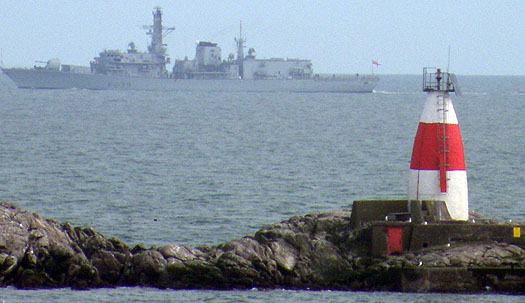
HMS Richmond passes the Muglins on Dublin Bay. Photo: Jehan Ashmore
Brosnan's visit to Dalkey was certainly a surprise for locals and tourists alike and will no doubt assist in boosting visitor numbers. By another coincidence on the same day, the town's Heritage Centre on Castle Street, the main street of the former port town for Dublin during medieval times, reopened after completion of a major upgrade of the visitor centre.
Unlike the former Bond's notable presence, HMS Richmond slipped quietly out of Dublin Bay today. Having said that, could there be a connection!....According to yesterday's Irish Times –The Social Network column, among his next film projects is 'November Man', an espionage movie. He quoted "...the stage is big enough for Daniel and myself".



























